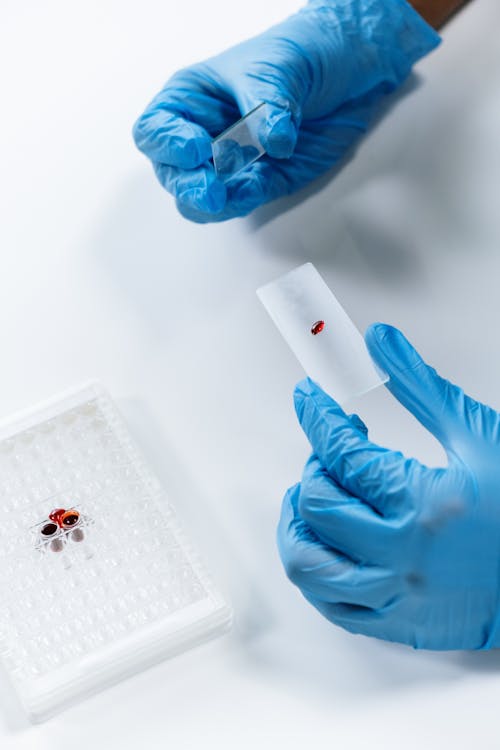What Does FBC Mean In A Blood Test?


A typical test called a complete blood count (FBC) is a very common blood test that might provide you with vital details about the types and amounts of cells in your blood. It helps to identify and track whether you have any diseases or medical conditions and therapies and check your overall health.

A blood sample from an arm vein and collection in a tube is required for an FBC, a frequently requested blood test. This tube is sent to the lab for examination.
An FBC's results may tell you about the three primary cell types in your blood:
Red blood cells – contain hemoglobin, which aids in carrying oxygen from your blood to other body regions.
White blood cells – have several types of white blood cells, and each one contributes differently to the body's capacity to fight infection. The differential method classifies a person's white blood cells into each type, including lymphocytes, neutrophils, monocytes, eosinophils, and basophils.
Platelets – these blood cells aid blood clots, such as when you are wounded.
The FBC test is crucial for identifying diseases in which the quantity of blood cells is out of the ordinary, either excessive or low. In the findings, you can see how many of the three cell types are present in your blood and a reference range that lets you know if the amount is low, normal, or excessive. It could also note overall cell production with unusual size or form.
Blood carries oxygen and nutrients to all the tissues; white blood cell populations, and antibodies to diagnose infection; forms blood clots to stop abnormal bleeding; and oxygen carries protein waste products to the liver and kidneys, which help filter and clean the blood. Blood also clots to stop bleeding.
For more information and our comprehensive guide to blood tests, click here.
Upper and lower limit values are provided through reference ranges. These ranges or numbers are thought of as typical upper or lower bounds. They are determined depending on the population being examined and the test apparatus.
As a result, reference ranges are set by each medical testing laboratory and might differ across laboratories. It implies that utilising the data supplied by the testing laboratory; you must interpret your findings with the help of your healthcare physician.
Haemoglobin, hematocrit, and red blood cell counts are a few methods for calculating the number of red blood cells in an FBC. In most cases, the haemoglobin value is considered the most significant.
Your doctor or nurse may recommend a reticulocyte count in certain unusual kinds of anaemia to see if your body produces new red cells.
The examination might also reveal any abnormally sized or shaped red blood cells you may possess. The mean cell volume is used to determine the size of the cells (MCV).
A phenomenon known as a "white blood cell difference" is also detected by several FBC tests. All the various kinds of white blood cells present and their levels are indicated since the term difference in this context refers to differentiating WBCs. Different cell types include neutrophils, lymphocytes, monocytes, eosinophils, and basophils.
Increased levels of specific white blood cells may be utilised to determine whether a virus or bacterium is to blame for an illness. A lot of one kind of white blood cell is produced by certain blood cancer, which prevents the healthy development of the other cell types. The blood test results could also reveal any white blood cells in your system that have an unusual appearance.
One number represents the entire platelet count. If the platelets have an odd appearance, the blood test with a full blood count can also indicate that.

Most of the time, no specific training is required before the exam. Typically, a common FBC test entails the following:
You are instructed to sit or lay down during the procedure.
Your arm is wrapped in a tourniquet, which is then tightened to accelerate blood flow through your veins. To help fill your veins with blood, the doctor, nurse, or technician may instruct you to clench and unclench your fist.
Clean the area to lower the risk of infection, and alcohol preparation is applied to the injection site.
The doctor, nurse, or technician draws your blood from a vein and then collects it in a vial or syringe. You can feel uncomfortable during the process, although this usually is not too bad.
The individual collecting the blood count test sample will instruct you to apply gauze or cotton wool to the injection site to reduce bleeding after the blood tests have been extracted. They will use an adhesive dressing on the injection site. You can get a little bruising where the injection was done for a day or two.

Full blood examination:
counts the sample's total number of red cell distribution width, white, and platelet cells.
calculates the ratio of red blood cells to plasma, sometimes called hematocrit.
Determines the number of each subgroup of white cells.
Finds the "mean cell hemoglobin," commonly referred to as the average amount of cell haemoglobin in red blood cells.
Determines the red cell's average size (mean cell volume)
If necessary, reviews the blood cell production under a microscope (blood smear/film).

A regular checkup usually does not need an FBC if you are healthy and symptom-free. For more details on our FBC test click here. Typically, an FBC is utilised to aid in diagnosing and overseeing many illnesses and therapies. An FBC may be used for:
discovering the cause of anemia, such as iron deficiency anaemia, by diagnosing the condition.
detecting infections, often in conjunction with a CRP test
assisting in the diagnosis of several blood illnesses, such as leukaemia, bone marrow failure, and thalassemia
aiding in the diagnosis of specific immune system issues
seeing how certain medications or radiation treatments are responding.
assisting in blood film examination of unusual bleeding or clotting
ensuring the safety of any upcoming major lab test procedure.
Blood is taken by inserting a needle into a vein in your arm. An elastic band encircles your upper arm. Initially, it could feel constrictive. The hand may cause you to feel nothing or a little fleeting pain or pressure. A tube containing the blood sample is filled, and it is then sent to the lab for examination.

It is advisable to interpret blood test results in cooperation with your healthcare advisor or family doctor since it is not always simple. They will be familiar with your typical range and how these findings relate the important medical data to your general health.
If there is a little abnormality, the test must be repeated in one to two months. It is because many alterations might be transient, and your results can revert to normal without further effort.
Results of an FBC test by itself often cannot provide a diagnosis of a disease. However, they might provide crucial hints about potential health issues.
Low hemoglobin is a sign of anemia for many different reasons. Iron deficiency, heavy bleeding or alcohol use, bone marrow problems, thyroid disorders, renal disorders, a lack of B12 or folate, and specific hereditary abnormalities like thalassemia. By examining additional test findings, such as the size of the cells or the mean cell volume, it is feasible to reduce the list of potential explanations (MCV). For instance, the MCV and ferritin levels are often low in people with iron insufficiency. Tests for ferritin are not included in the FBC.
Smoking, underlying lung or heart illness, or issues with your bone marrow may contribute to high hemoglobin levels.
Low white blood cell counts might be hereditary (run in families) and are not always harmful. But other potential causes include issues with your immune system, affect bone marrow production, or certain infections.
A high white blood cell count often indicates that you have an existing infection in your body. Rarely, however, may it indicate a more severe condition like leukaemia. Additionally, it could be hereditary and run in families.
Autoimmune conditions or viral infections may also result in low platelet counts (where your immune system attacks healthy tissue).
Inflammatory diseases, severe infections, or an issue with your bone marrow may contribute to an elevated platelet count.
Red blood cell and platelet levels may be determined from the FBC test's several findings. These "average ranges" provide a broad overview. Hemoglobin levels, however, may be impacted by several variables, including age, pregnancy, and different hospital laboratories. Therefore, each situation's context must be taken into account when determining the importance of a common blood test result.
Red blood cells with anaemia have to work harder to obtain oxygen into their cells. Rarely are aneurysms detected before their size or rupture.
For a full range of blood tests and medications, visit our Welzo Online Pharmacy Page. For more details, click here.
Plus get the inside scoop on our latest content and updates in our monthly newsletter.